The Dynamic Changes of Lake Issyk-Kul from 1958 to 2020 Based on Multi-Source Satellite Data
Abstract
:1. Introduction
2. Materials and Methods
2.1. Study Area
2.2. Data
2.2.1. Lake Level Dataset
2.2.2. Lake Area Dataset
2.2.3. Meteorological Data
2.2.4. Glacier Data
2.2.5. Other Relevant Data
2.3. Methods
2.3.1. Lake Level Extraction
- 1.
- Satellite altimetry data pre-processing
- 2.
- Outlier removal
- 3.
- Multi-source water level data merging
2.3.2. Lake Area Extraction
2.3.3. Accuracy Verification
2.3.4. Estimation of Water Volume Change
3. Results
3.1. Variations in the Water Level of Lake Issyk-Kul
3.2. Variations in Area of Lake Issyk-Kul
3.3. Variations in the Water Volume of Lake Issyk-Kul
4. Discussion
4.1. Accuracy Verification
4.1.1. Accuracy Verification of Water Level
4.1.2. Accuracy Verification of Water Area
4.2. The Driving Force of the Dynamic Changes of Lake Issyk-Kul
4.2.1. Climate Change
4.2.2. Glacier Meltwater
4.2.3. Human Activities
5. Conclusions
Author Contributions
Funding
Institutional Review Board Statement
Informed Consent Statement
Data Availability Statement
Acknowledgments
Conflicts of Interest
References
- Zhang, X.; Wu, Y. Zhari NamcoWater Level Change Detection Using Multi-satellite Altimetric Data during 1992–2012. J. Nat. Resour. 2015, 30, 1153–1162. [Google Scholar]
- Asfaw, W.; Haile, A.T.; Rientjes, T. Combining multisource satellite data to estimate storage variation of a lake in the Rift Valley Basin, Ethiopia. Int. J. Appl. Earth Obs. Geoinf. 2020, 89, 102095. [Google Scholar] [CrossRef]
- Li, P.; Li, H.; Chen, F.; Cai, X. Monitoring Long-Term Lake Level Variations in Middle and Lower Yangtze Basin over 2002–2017 through Integration of Multiple Satellite Altimetry Datasets. Remote Sens. 2020, 12, 1448. [Google Scholar] [CrossRef]
- Han, Q.; Zhang, S.; Huang, G.; Zhang, R. Analysis of Long-Term Water Level Variation in Dongting Lake, China. Water 2016, 8, 306. [Google Scholar]
- Long, A.; Deng, M.; Xie, L.; Wang, J.; Li, X. A Study of the Water Balance of Lake Balkhash. J. Glaciol. Geocryol. 2011, 33, 1341–1352. [Google Scholar]
- Gibson, J.J.; Prowse, T.D.; Peters, D.L. Partitioning impacts of climate and regulation on water level variability in Great Slave Lake. J. Hydrol. 2006, 329, 196–206. [Google Scholar] [CrossRef]
- Biancamaria, S.; Andreadis, K.M.; Durand, M.; Clark, E.A.; Rodriguez, E.; Mognard, N.M.; Alsdorf, D.E.; Lettenmaier, D.P.; Oudin, Y. Preliminary Characterization of SWOT Hydrology Error Budget and Global Capabilities. IEEE J. Sel. Top. Appl. Earth Obs. Remote Sens. 2010, 3, 6–19. [Google Scholar] [CrossRef] [Green Version]
- Song, C.Q.; Ye, Q.H.; Sheng, Y.W.; Gong, T.L. Combined ICESat and CryoSat-2 Altimetry for Accessing Water Level Dynamics of Tibetan Lakes over 2003–2014. Water 2015, 7, 4685–4700. [Google Scholar] [CrossRef] [Green Version]
- Jiang, L.G.; Nielsen, K.; Andersen, O.B.; Bauer-Gottwein, P. Monitoring recent lake level variations on the Tibetan Plateau using CryoSat-2 SARIn mode data. J. Hydrol. 2017, 544, 109–124. [Google Scholar] [CrossRef] [Green Version]
- Junli, L.I.; Xi, C.; Anming, B.A.O. Spatial-temporal Characteristics of Lake Level Changes in Central Asia during 2003–2009. Acta Geogr. Sin. 2011, 66, 1219–1229. [Google Scholar]
- Yang, X.; Li, G.; Wang, P.; Chang, X.; Yao, J. Monitoring of Qinghai Lake changes with spaceborne laser altimetry and remote sensing images. Sci. Surv. Mapp. 2020, 45, 79–87. [Google Scholar]
- Li, S.; Chen, J.P.; Xiang, J.; Pan, Y.; Huang, Z.Y.; Wu, Y.L. Water level changes of Hulun Lake in Inner Mongolia derived from Jason satellite data. J. Vis. Commun. Image Represent. 2019, 58, 565–575. [Google Scholar] [CrossRef]
- Liao, J.; Zhao, Y.; Chen, J. A dataset of lake level changes in High Mountain Asia using multialtimeter data. China Sci. Data 2020, 5, 1–12. [Google Scholar]
- Baup, F.; Frappart, F.; Maubant, J. Combining high-resolution satellite images and altimetry to estimate the volume of small lakes. Hydrol. Earth Syst. Sci. 2014, 18, 2007–2020. [Google Scholar] [CrossRef] [Green Version]
- Qiao, B.J.; Zhu, L.P.; Wang, J.B.; Ju, J.T.; Ma, Q.F.; Huang, L.; Chen, H.; Liu, C.; Xu, T. Estimation of lake water storage and changes based on bathymetric data and altimetry data and the association with climate change in the central Tibetan Plateau. J. Hydrol. 2019, 578. [Google Scholar] [CrossRef]
- Yao, F.F.; Wang, J.D.; Yang, K.H.; Wang, C.; Walter, B.A.; Crétaux, J.-F. Lake storage variation on the endorheic Tibetan Plateau and its attribution to climate change since the new millennium. Environ. Res. Lett. 2018, 13, 064011. [Google Scholar] [CrossRef]
- Phan, V.H.; Lindenbergh, R.; Menenti, M. ICESat derived elevation changes of Tibetan lakes between 2003 and 2009. Int. J. Appl. Earth Obs. Geoinf. 2012, 17, 12–22. [Google Scholar] [CrossRef]
- Wang, X.W.; Gong, P.; Zhao, Y.Y.; Xu, Y.; Cheng, X.; Niu, Z.G.; Luo, Z.C.; Huang, H.B.; Sun, F.D.; Li, X.W. Water-level changes in China’s large lakes determined from ICESat/GLAS data. Remote Sens. Environ. 2013, 132, 131–144. [Google Scholar]
- An, D.; Yang, J.; Wu, Y.; Ma, X.; Tao, D.; Shi, H. Current Research Progress and Applications of ICESat-2 Laser Altimetry Satellite. Hydrogr. Surv. Charting 2019, 39, 9–15. [Google Scholar]
- Villladsen, H.; Andersen, O.B.; Stenseng, L. Annual Cycle in Lakes and Rivers from Cryosat-2 Altimetry—The Brahmaputra River. In Proceedings of the IEEE Joint International Geoscience and Remote Sensing Symposium (IGARSS)/35th Canadian Symposium on Remote Sensing, Quebec City, QC, Canada, 13–18 July 2014; IEEE: New Piscataway, NJ, USA, 2014; pp. 894–897. [Google Scholar]
- Busker, T.; de Roo, A.; Gelati, E.; Schwatke, C.; Adamovic, M.; Bisselink, B.; Pekel, J.-F.; Cottam, A. A global lake and reservoir volume analysis using a surface water dataset and satellite altimetry. Hydrol. Earth Syst. Sci. 2019, 23, 669–690. [Google Scholar] [CrossRef] [Green Version]
- Ferronskii, V.I.; Polyakov, V.A.; Brezgunov, V.S.; Vlasova, L.S.; Karpychev, Y.A.; Bobkov, A.F.; Romaniovskii, V.V.; Johnson, T.; Ricketts, D.; Rasmussen, K. Variations in the Hydrological Regime of Kara-Bogaz-Gol Gulf, Lake Issyk-Kul, and the Aral Sea Assessed Based on Data of Bottom Sediment Studies. Water Resour. 2003, 30, 252–259. [Google Scholar]
- Wang, G.; Shen, Y.; Qin, D. Issyk-Kul Lake Level Fluctuation during 1860–2005 and Its Relation with Regional Climatic and Hydrological Changes. J. Glaciol. Geocryol. 2006, 28, 854–860. [Google Scholar]
- Uulu Salamat, A.; Abuduwaili, J.; Shaidyldaeva, N. Impact of climate change on water level fluctuation of Issyk-Kul Lake. Arab. J. Geosci. 2015, 8, 5361–5371. [Google Scholar] [CrossRef]
- Mihrigul, A.; Hamid, Y.; Mamattursun, E.; Shakure, T.; Yorov, H. Water Level Variations of Issyk-Kul Lake Based on Wavelet Analysis. Res. Soil Water Conserv. 2014, 21, 168–172. [Google Scholar]
- Alymkulova, B.; Abuduwaili, J.; Issanova, G.; Nahayo, L. Consideration of Water Uses for Its Sustainable Management, the Case of Issyk-Kul Lake, Kyrgyzstan. Water 2016, 8, 9. [Google Scholar]
- Reyes, R.; Nagai, M.; Blanco, A. Lake water level variability determination from SAR backscatter of discrete objects, GNSS levelling and satellite altimetry. Surv. Rev. 2021, 54, 153–162. [Google Scholar] [CrossRef]
- Alifujiang, Y.; Abuduwaili, J.; Ma, L.; Samat, A.; Groll, M. System Dynamics Modeling of Water Level Variations of Lake Issyk-Kul, Kyrgyzstan. Water 2017, 9, 20. [Google Scholar]
- Politi, E.; Rowan, J.S.; Cutler, M.E.J. Assessing the utility of geospatial technologies to investigate environmental change within lake systems. Sci. Total Environ. 2016, 543, 791–806. [Google Scholar] [CrossRef] [Green Version]
- Mueller, N.; Lewis, A.; Roberts, D.; Ring, S.; Melrose, R.; Sixsmith, J.; Lymburner, L.; McIntyre, A.; Tan, P.; Curnow, S.; et al. Water observations from space: Mapping surface water from 25 years of Landsat imagery across Australia. Remote Sens. Environ. 2016, 174, 341–352. [Google Scholar] [CrossRef] [Green Version]
- Yan, Z.; Guo, W. Remote sensing monitoring of the lake area of Issyk-Kul Lake in Central Asia from 1991 to 2014. Geomat. Spat. Inf. Technol. 2018, 41, 142–146. [Google Scholar]
- Bai, J.; Chen, X.; Li, J.; Yang, L. Changes of inland lake area in arid Central Asia during 1975–2007: A remote-sensing analysis. Hupo Kexue 2011, 23, 80–88. [Google Scholar]
- Schwatke, C.; Scherer, D.; Dettmering, D. Automated Extraction of Consistent Time-Variable Water Surfaces of Lakes and Reservoirs Based on Landsat and Sentinel-2. Remote Sens. 2019, 11, 1010. [Google Scholar] [CrossRef] [Green Version]
- Sun, W.W.; Du, B.; Xiong, S. Quantifying Sub-Pixel Surface Water Coverage in Urban Environments Using Low-Albedo Fraction from Landsat Imagery. Remote Sens. 2017, 9, 428. [Google Scholar] [CrossRef] [Green Version]
- Ogilvie, A.; Belaud, G.; Massuel, S.; Mulligan, M.; Le Goulven, P.; Calvez, R. Surface water monitoring in small water bodies: Potential and limits of multi-sensor Landsat time series. Hydrol. Earth Syst. Sci. 2018, 22, 4349–4380. [Google Scholar] [CrossRef] [Green Version]
- Feyisa, G.L.; Meilby, H.; Fensholt, R.; Proud, S.R. Automated Water Extraction Index: A new technique for surface water mapping using Landsat imagery. Remote Sens. Environ. 2014, 140, 23–35. [Google Scholar] [CrossRef]
- Young, N.E.; Anderson, R.S.; Chignell, S.M.; Vorster, A.G.; Lawrence, R.; Evangelista, P.H. A survival guide to Landsat preprocessing. Ecology 2017, 98, 920–932. [Google Scholar] [CrossRef] [Green Version]
- Ji, L.; Gong, P.; Geng, X.; Zhao, Y. Improving the Accuracy of the Water Surface Cover Type in the 30 m FROM-GLC Product. Remote Sens. 2015, 7, 13507–13527. [Google Scholar] [CrossRef] [Green Version]
- Gorelick, N.; Hancher, M.; Dixon, M.; Ilyushchenko, S.; Thau, D.; Moore, R. Google Earth Engine: Planetary-scale geospatial analysis for everyone. Remote Sens. Environ. 2017, 202, 18–27. [Google Scholar] [CrossRef]
- Nguyen, U.N.T.; Pham, L.T.H.; Dang, T.D. An automatic water detection approach using Landsat 8 OLI and Google earth engine cloud computing to map lakes and reservoirs in New Zealand. Environ. Monit. Assess. 2019, 191, 235, Erratum in Environ. Monit. Assess. 2020, 192, 616. [Google Scholar]
- Fattore, C.; Abate, N.; Faridani, F.; Masini, N.; Lasaponara, R. Google Earth Engine as Multi-Sensor Open-Source Tool for Supporting the Preservation of Archaeological Areas: The Case Study of Flood and Fire Mapping in Metaponto, Italy. Sensors 2021, 21, 1791. [Google Scholar] [CrossRef]
- Pekel, J.-F.; Cottam, A.; Gorelick, N.; Belward, A.S. High-resolution mapping of global surface water and its long-term changes. Nature 2016, 540, 418–422. [Google Scholar] [CrossRef] [PubMed]
- Yang, Y.J.; Zhang, Y.Y.; Su, X.W.; Hou, H.P.; Zhang, S.L. The spatial distribution and expansion of subsided wetlands induced by underground coal mining in eastern China. Environ. Earth Sci. 2021, 80, 1–14. [Google Scholar] [CrossRef]
- Rad, A.M.; Kreitler, J.; Sadegh, M. Augmented Normalized Difference Water Index for improved surface water monitoring. Environ. Model. Softw. 2021, 140, 105030. [Google Scholar] [CrossRef]
- Guo, Q.D.; Pu, R.L.; Li, J.L.; Cheng, J. A weighted normalized difference water index for water extraction using Landsat imagery. Int. J. Remote Sens. 2017, 38, 5430–5445. [Google Scholar] [CrossRef]
- Schwatke, C.; Dettmering, D.; Seitz, F. Volume Variations of Small Inland Water Bodies from a Combination of Satellite Altimetry and Optical Imagery. Remote Sens. 2020, 12, 1606. [Google Scholar] [CrossRef]
- Korzhenkov, A.M.; Deev, E.V.; Turova, I.V.; Abdieva, S.V.; Ivanov, S.S.; Liu, J.; Mazeika, I.V.; Rogozhin, E.A.; Strelnikov, A.A.; Fortuna, A.B.; et al. Active Tectonics and Paleoseismicity of the Eastern Issyk-Kul Basin (Kyrgyzstan, Tien Shan). Russ. Geol. Geophys. 2021, 62, 263–277. [Google Scholar]
- Romanovsky, V.V.; Tashbaeva, S.; Crétaux, J.-F.; Calmant, S.; Drolon, V. The closed Lake Issyk-Kul as an indicator of global warming in Tien-Shan. Nat. Sci. 2013, 5, 608–623. [Google Scholar] [CrossRef] [Green Version]
- Taft, J.B.; Phillippe, L.R.; Dietrich, C.; Robertson, K.R. Grassland composition, structure, and diversity patterns along major environmental gradients in the Central Tien Shan. Plant Ecol. 2011, 212, 1349–1361. [Google Scholar] [CrossRef]
- Wang, G.; Shen, Y.; Wang, N.; Wu, Q. The Effects of Climate Change and Human Activities on the Lake Level of the Issyk-Kul during the Past 100 Years. J. Glaciol. Geocryol. 2010, 32, 1097–1105. [Google Scholar]
- Alifujiang, Y.; Abuduwaili, J.; Maihemuti, B.; Emin, B.; Groll, M. Innovative Trend Analysis of Precipitation in the Lake Issyk-Kul Basin, Kyrgyzstan. Atmosphere 2020, 11, 16. [Google Scholar]
- Narama, C.; Kaab, A.; Duishonakunov, M.; Abdrakhmatov, K. Spatial variability of recent glacier area changes in the Tien Shan Mountains, Central Asia, using Corona (similar to 1970), Landsat (similar to 2000), and ALOS (similar to 2007) satellite data. Glob. Planet. Change 2010, 71, 42–54. [Google Scholar]
- Yilinuer, A.; Jilili, A.; Ding, Z.; Sun, J. Analysis of the Difference of Runoff Variation and Its Influencing Factors in the Typical Small Watershed of Issyk-Kul Basin. J. Soil Water Conserv. 2020, 34, 198–210. [Google Scholar]
- Markus, T.; Neumann, T.; Martino, A.; Abdalati, W.; Brunt, K.; Csatho, B.; Farrell, S.; Fricker, H.; Gardner, A.; Harding, D.; et al. The Ice, Cloud, and land Elevation Satellite-2 (ICESat-2): Science requirements, concept, and implementation. Remote Sens. Environ. 2017, 190, 260–273. [Google Scholar] [CrossRef]
- ESRIN-ESA and Mullard Space Science Laboratory. CryoSat Product Handbook; European Space Agency: Paris, France, 2021; Volume DLFE-3605. [Google Scholar]
- Parrinello, T.; Shepherd, A.; Bouffard, J.; Badessi, S.; Casal, T.; Davidson, M.; Fornari, M.; Maestroni, E.; Scagliola, M. CryoSat: ESA’s ice mission—Eight years in space. Adv. Space Res. 2018, 62, 1178–1190. [Google Scholar]
- Ferraro, E.J.; Swift, C.T. Comparison of retracking algorithms using airborne radar and laser altimeter measurements of the Greenland ice sheet. IEEE Trans. Geosci. Remote Sens. 1995, 33, 700–707. [Google Scholar] [CrossRef] [Green Version]
- Yuan, C.; Gong, P.; Bai, Y.Q. Performance Assessment of ICESat-2 Laser Altimeter Data for Water-Level Measurement over Lakes and Reservoirs in China. Remote Sens. 2020, 12, 770. [Google Scholar] [CrossRef] [Green Version]
- Foga, S.; Scaramuzza, P.L.; Guo, S.; Zhu, Z.; Dilley, R.D.; Beckmann, T.; Schmidt, G.L.; Dwyer, J.L.; Hughes, M.J.; Laue, B. Cloud detection algorithm comparison and validation for operational Landsat data products. Remote Sens. Environ. 2017, 194, 379–390. [Google Scholar] [CrossRef] [Green Version]
- Tucker, C.J.; Grant, D.M.; Dykstra, J.D. NASAs global orthorectified landsat data set. Photogramm. Eng. Remote Sens. 2004, 70, 313–322. [Google Scholar]
- Hoffmann, L.; Gunther, G.; Li, D.; Stein, O.; Wu, X.; Griessbach, S.; Heng, Y.; Konopka, P.; Muller, R.; Vogel, B.; et al. From ERA-Interim to ERA5: The considerable impact of ECMWF’s next-generation reanalysis on Lagrangian transport simulations. Atmos. Chem. Phys. 2019, 19, 3097–3124. [Google Scholar]
- Hersbach, H.; Bell, B.; Berrisford, P.; Hirahara, S.; Horanyi, A.; Munoz-Sabater, J.; Nicolas, J.; Peubey, C.; Radu, R.; Schepers, D.; et al. The ERA5 global reanalysis. Q. J. R. Meteorol Soc. 2020, 146, 1999–2049. [Google Scholar]
- Pfeffer, W.T.; Arendt, A.A.; Bliss, A.; Bolch, T.; Cogley, J.G.; Gardner, A.S.; Hagen, J.O.; Hock, R.; Kaser, G.; Kienholz, C.; et al. The Randolph Glacier Inventory: A globally complete inventory of glaciers. J. Glaciol. 2014, 60, 537–552. [Google Scholar]
- Radić, V.; Hock, R. Regional and global volumes of glaciers derived from statistical upscaling of glacier inventory data. J. Geophys. Res. Earth Surf. 2010, 115, F01010. [Google Scholar] [CrossRef]
- Wen, J.; Zhao, H.; Jiang, Y.; Chen, D.; Ji, G. Research on the quality screening method for satellite altimetry data take Jason-3 data and Hongze Lake as an example. SN Water Transf. Water Sci. Technol. 2018, 16, 194. [Google Scholar]
- Xu, H. Modification of normalised difference water index (NDWI) to enhance open water features in remotely sensed imagery. Int. J. Remote Sens. 2006, 27, 3025–3033. [Google Scholar] [CrossRef]
- Qiao, B.J.; Zhu, L.P.; Wang, J.B.; Ju, J.T.; Ma, Q.F.; Liu, C. Estimation of lakes water storage and their changes on the northwestern Tibetan Plateau based on bathymetric and Landsat data and driving force analyses. Quat. Int. 2017, 454, 56–67. [Google Scholar] [CrossRef]
- Qiao, B.J.; Zhu, L.P.; Yang, R.M. Temporal-spatial differences in lake water storage changes and their links to climate change throughout the Tibetan Plateau. Remote Sens. Environ. 2019, 222, 232–243. [Google Scholar] [CrossRef]
- Qiao, B.; Zhu, L.; Qiao, B.J.; Zhu, L.P. Differences and cause analysis of changes in lakes of different supply types in the north-western Tibetan Plateau. Hydrol. Process. 2017, 31, 2752–2763. [Google Scholar] [CrossRef]
- Xu, N.; Ma, Y.; Zhang, W.H.; Wang, X.H.; Yang, F.L.; Su, D.P. Monitoring Annual Changes of Lake Water Levels and Volumes over 1984–2018 Using Landsat Imagery and ICESat-2 Data. Remote Sens. 2020, 12, 4004. [Google Scholar] [CrossRef]
- Jiang, L.G.; Nielsen, K.; Andersen, O.B.; Bauer-Gottwein, P. A Bigger Picture of how the Tibetan Lakes Have Changed Over the Past Decade Revealed by CryoSat-2 Altimetry. J. Geophys. Res. Atmos. 2020, 125, e2020JD033161. [Google Scholar] [CrossRef]
- Xu, X.F.; Yuan, L.G.; Jiang, Z.S.; Chen, C.F.; Cheng, S. Lake level changes determined by Cryosat-2 altimetry data and water-induced loading deformation around Lake Qinghai. Adv. Space Res. 2020, 66, 2568–2582. [Google Scholar] [CrossRef]
- Ma, Z.G.; Guo, Q.Y.; Yang, F.Y.; Chen, H.L.; Li, W.Q.; Lin, L.L.; Zheng, C.Y. Recent Changes in Temperature and Precipitation of the Summer and Autumn Seasons over Fujian Province, China. Water 2021, 13, 1900. [Google Scholar] [CrossRef]
- Sorg, A.; Bolch, T.; Stoffel, M.; Solomina, O.; Beniston, M. Climate change impacts on glaciers and runoff in Tien Shan (Central Asia). Nat. Clim. Chang. 2012, 2, 725–731. [Google Scholar] [CrossRef]
- Savvaitova, K.; Petr, T. Lake Issyk-kul, Kirgizia. Int. J. Salt Lake Res. 1992, 1, 21–46. [Google Scholar]
- Vollmer, M.K.; Weiss, R.F.; Williams, R.T.; Falkner, K.K.; Qiu, X.; Ralph, E.A.; Romanovsky, V.V. Physical and chemical properties of the waters of saline lakes and their importance for deep-water renewal: Lake Issyk-Kul, Kyrgyzstan. Geochim. Cosmochim. Acta 2002, 66, 4235–4246. [Google Scholar] [CrossRef]
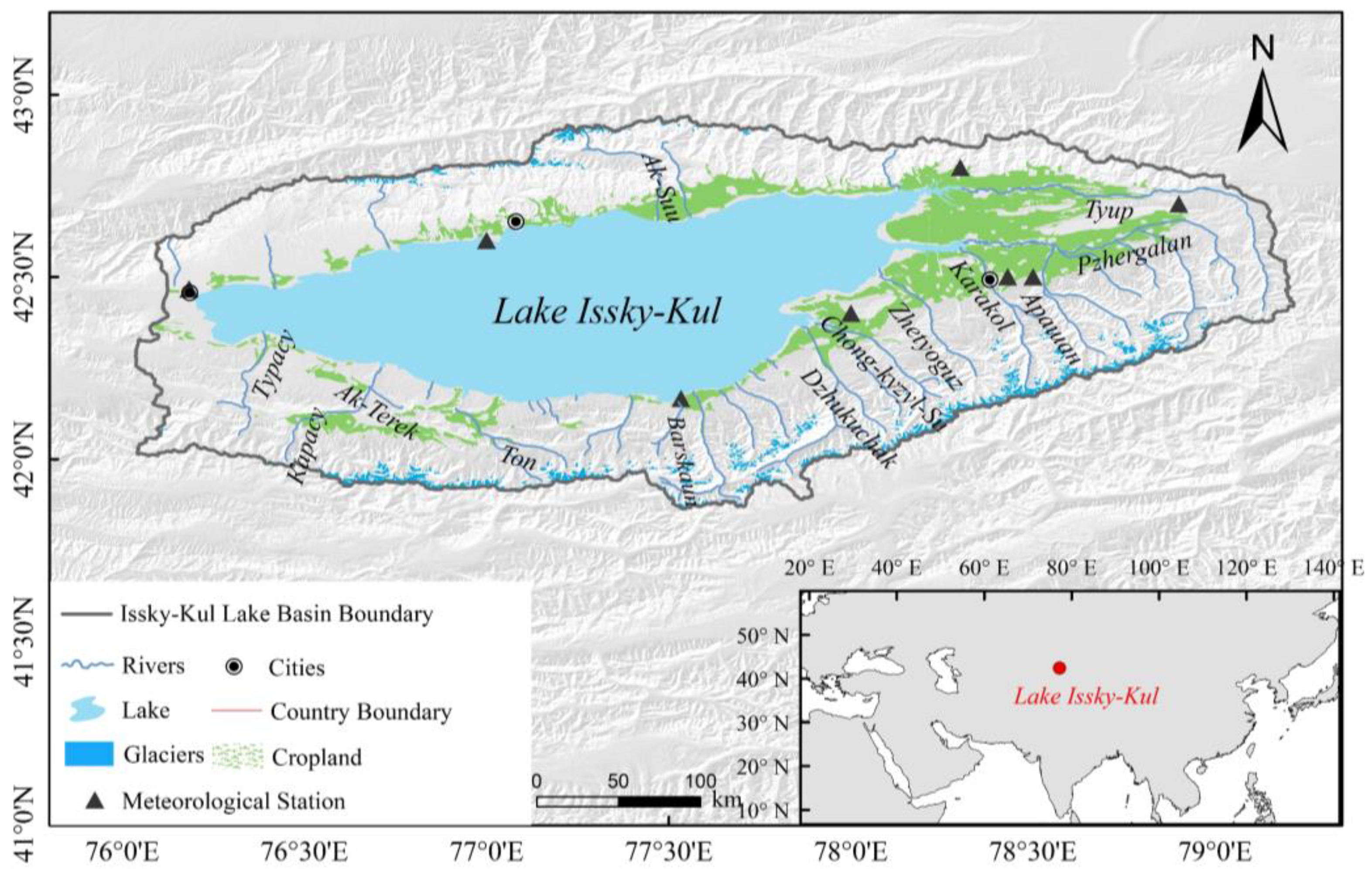
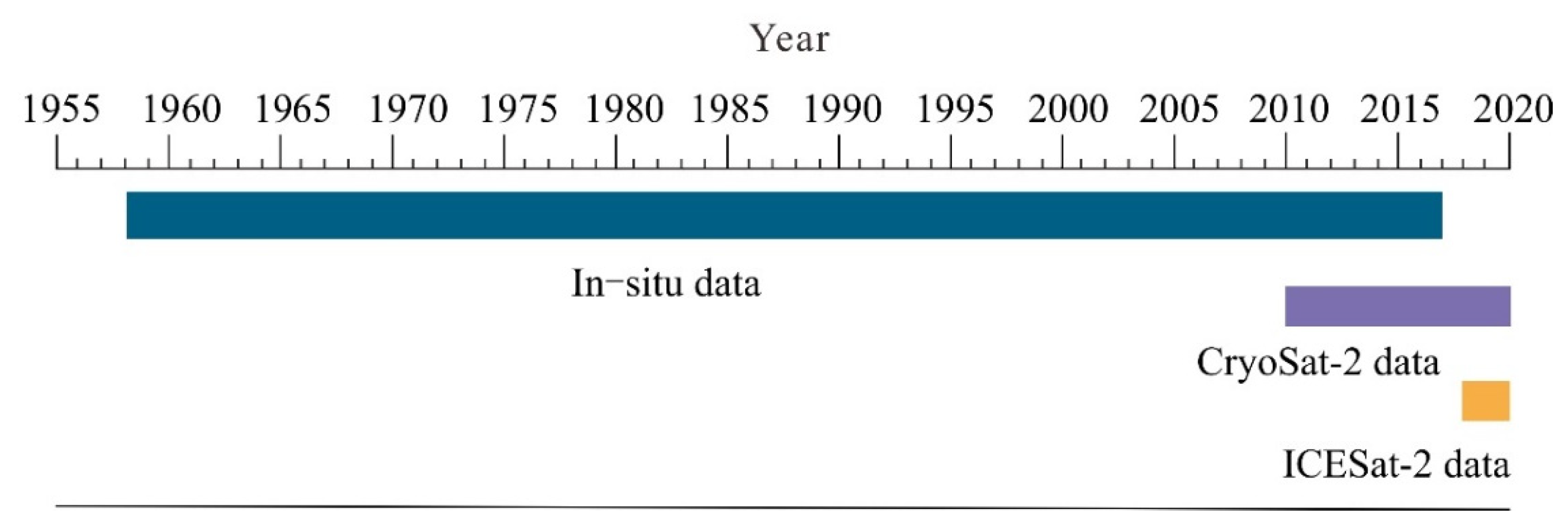
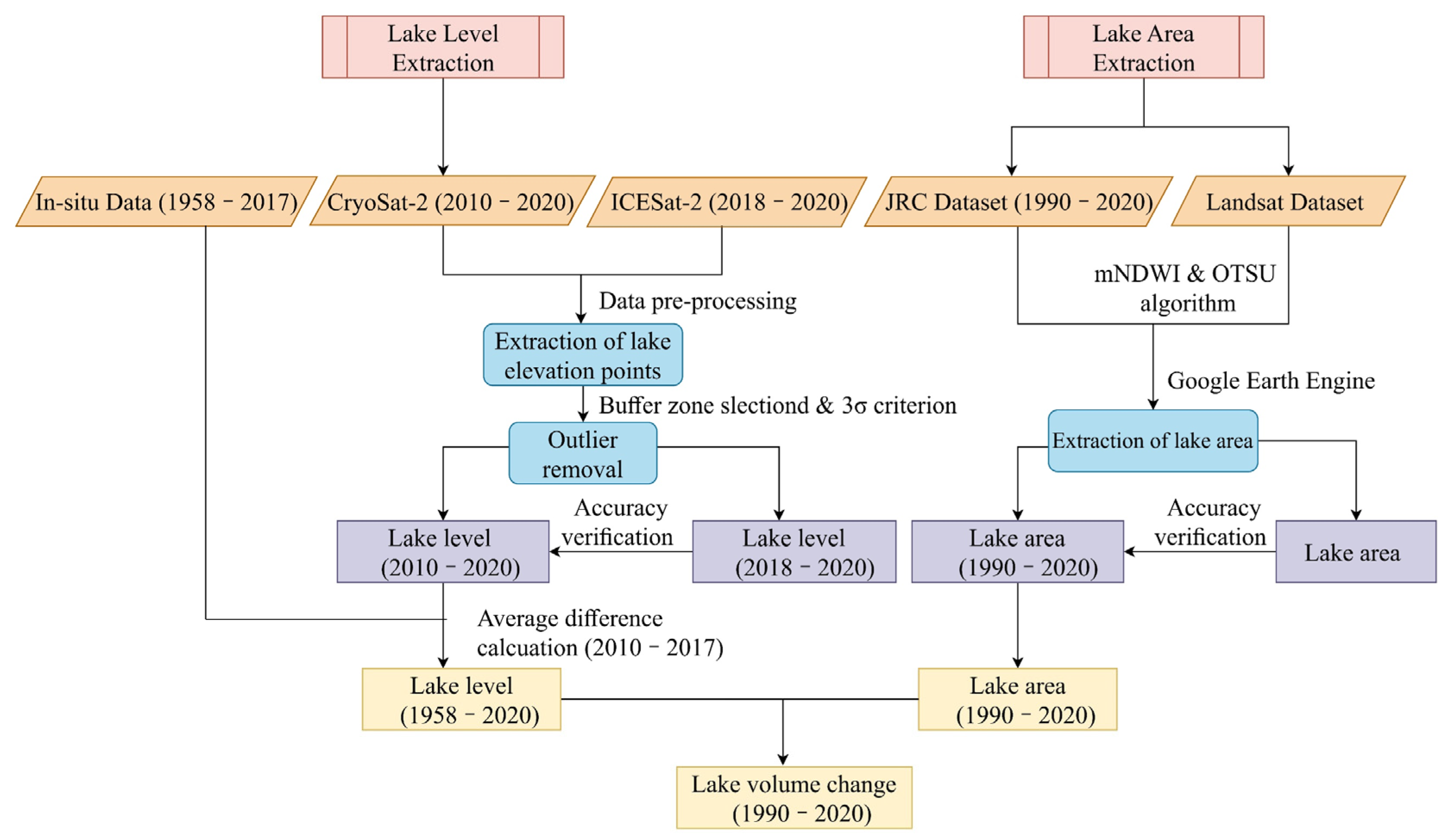

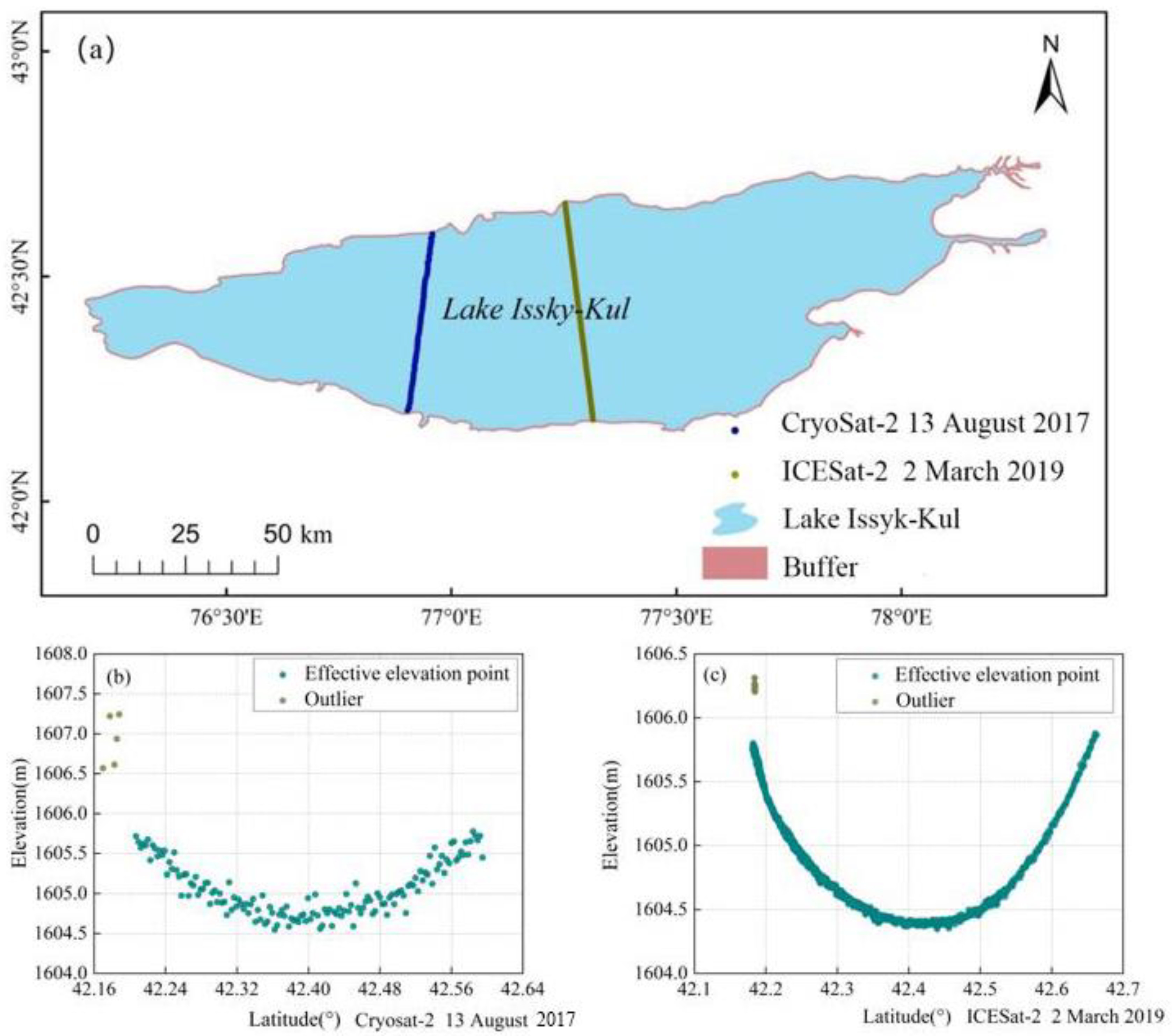
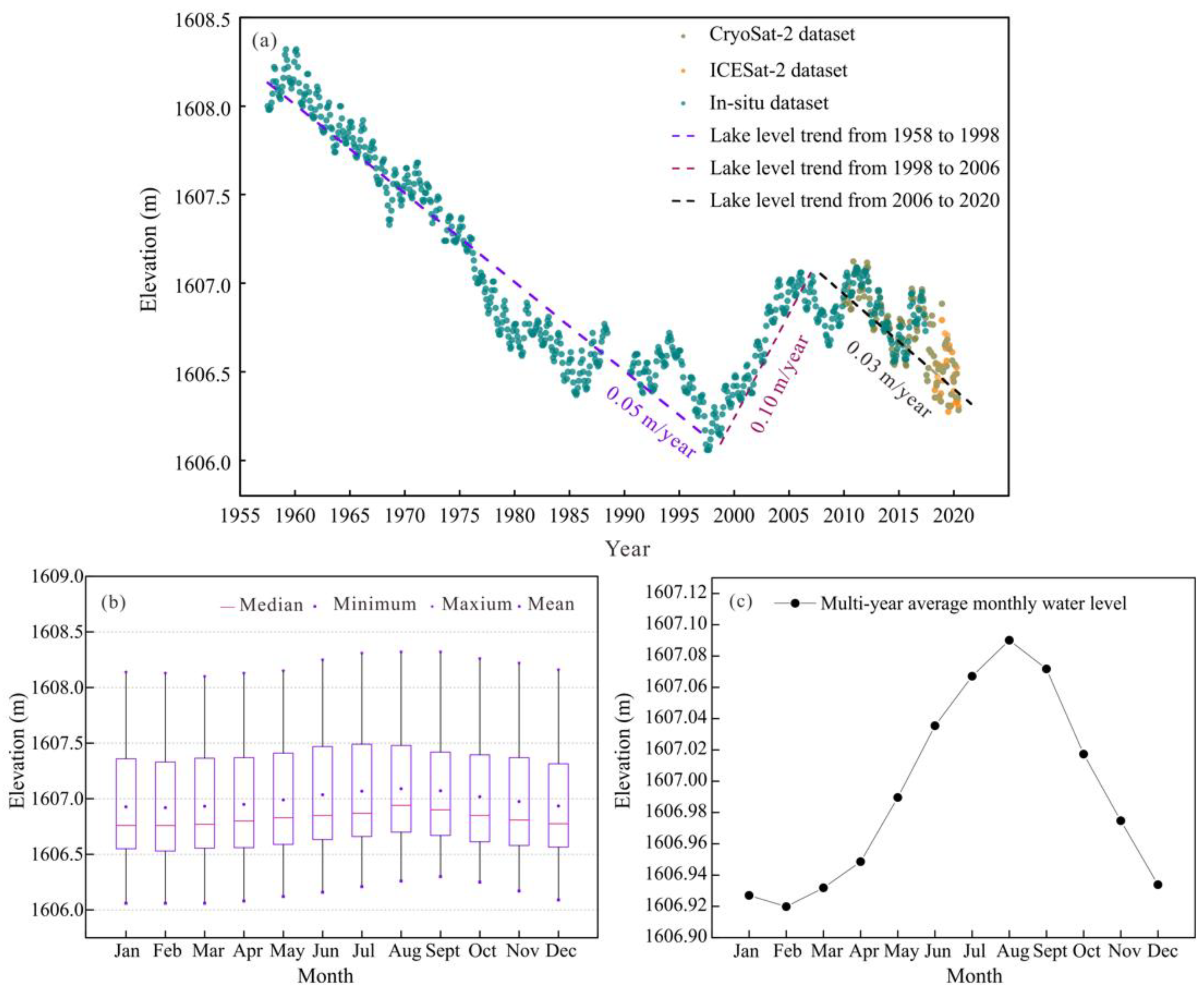
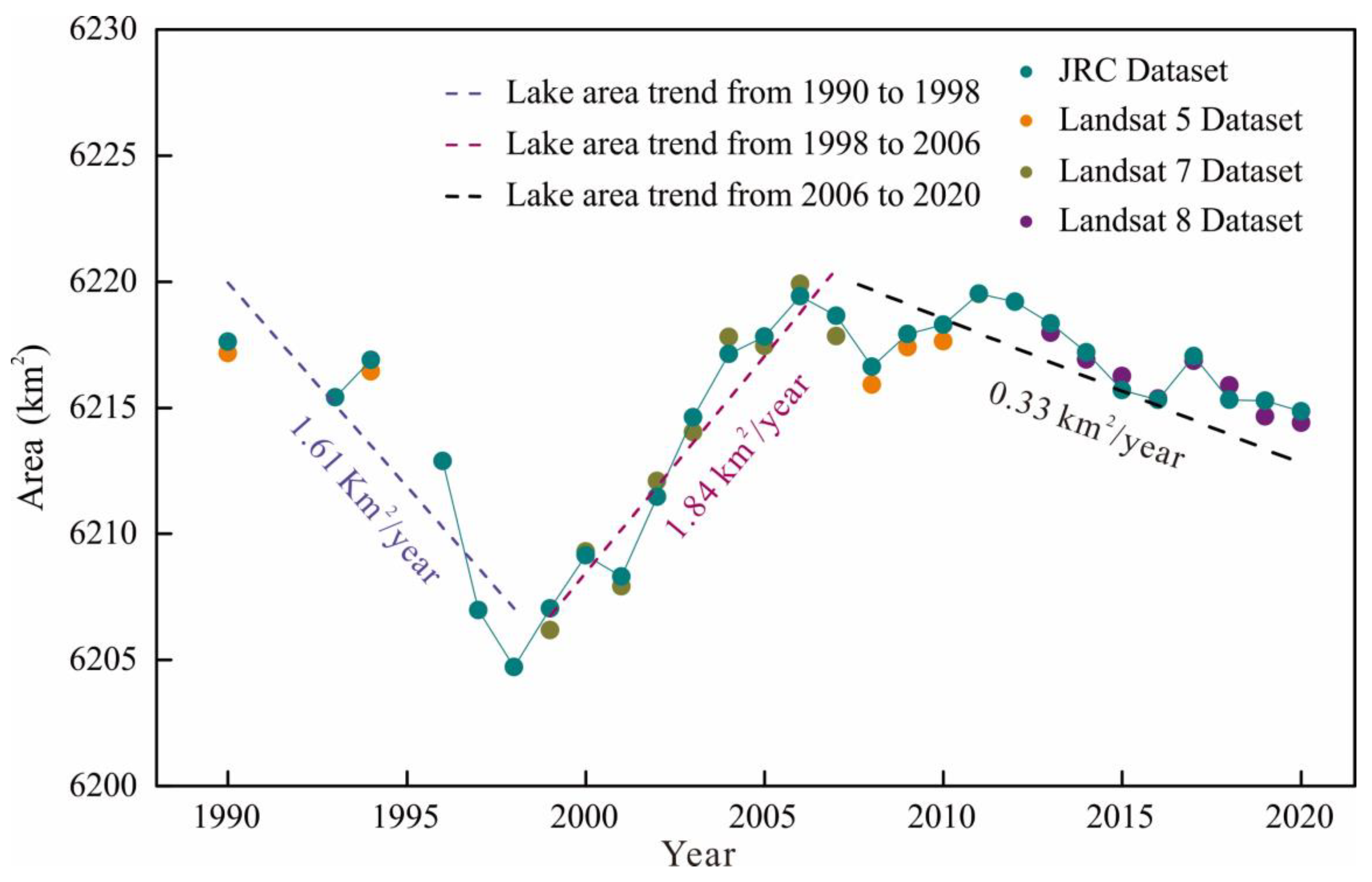
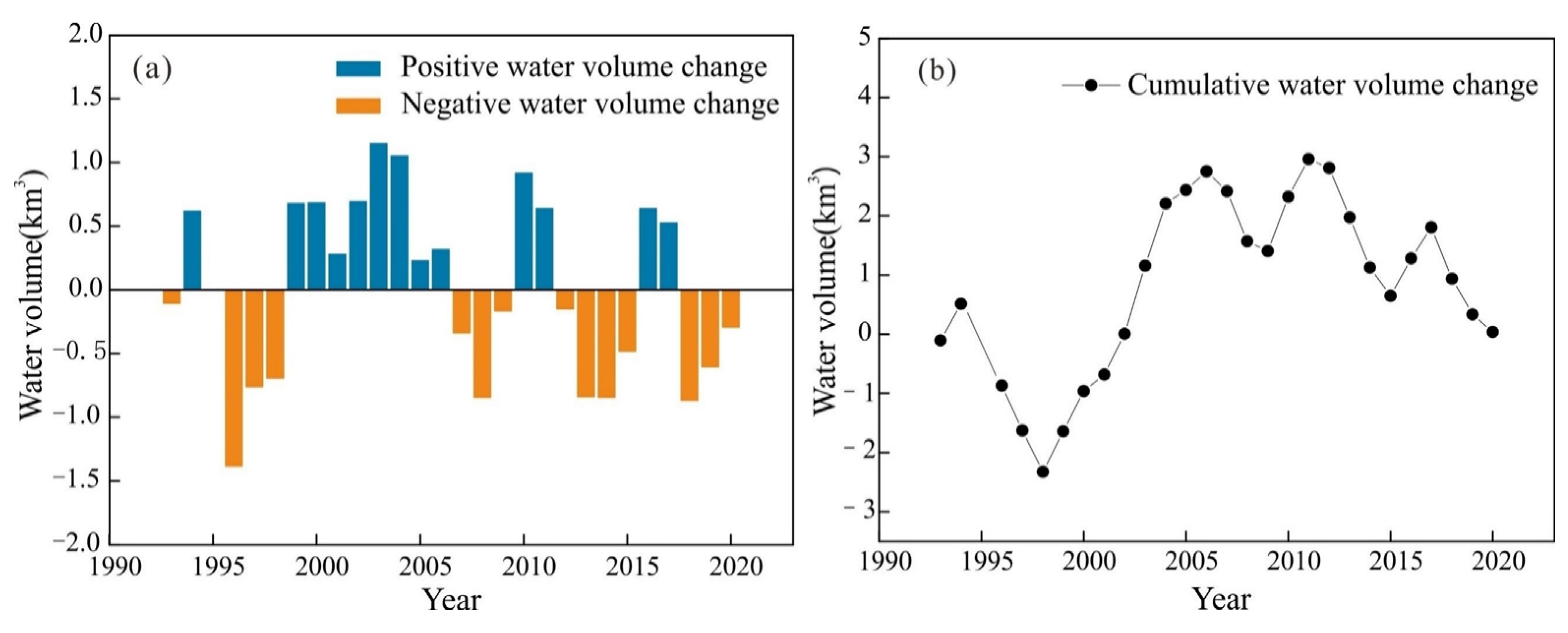
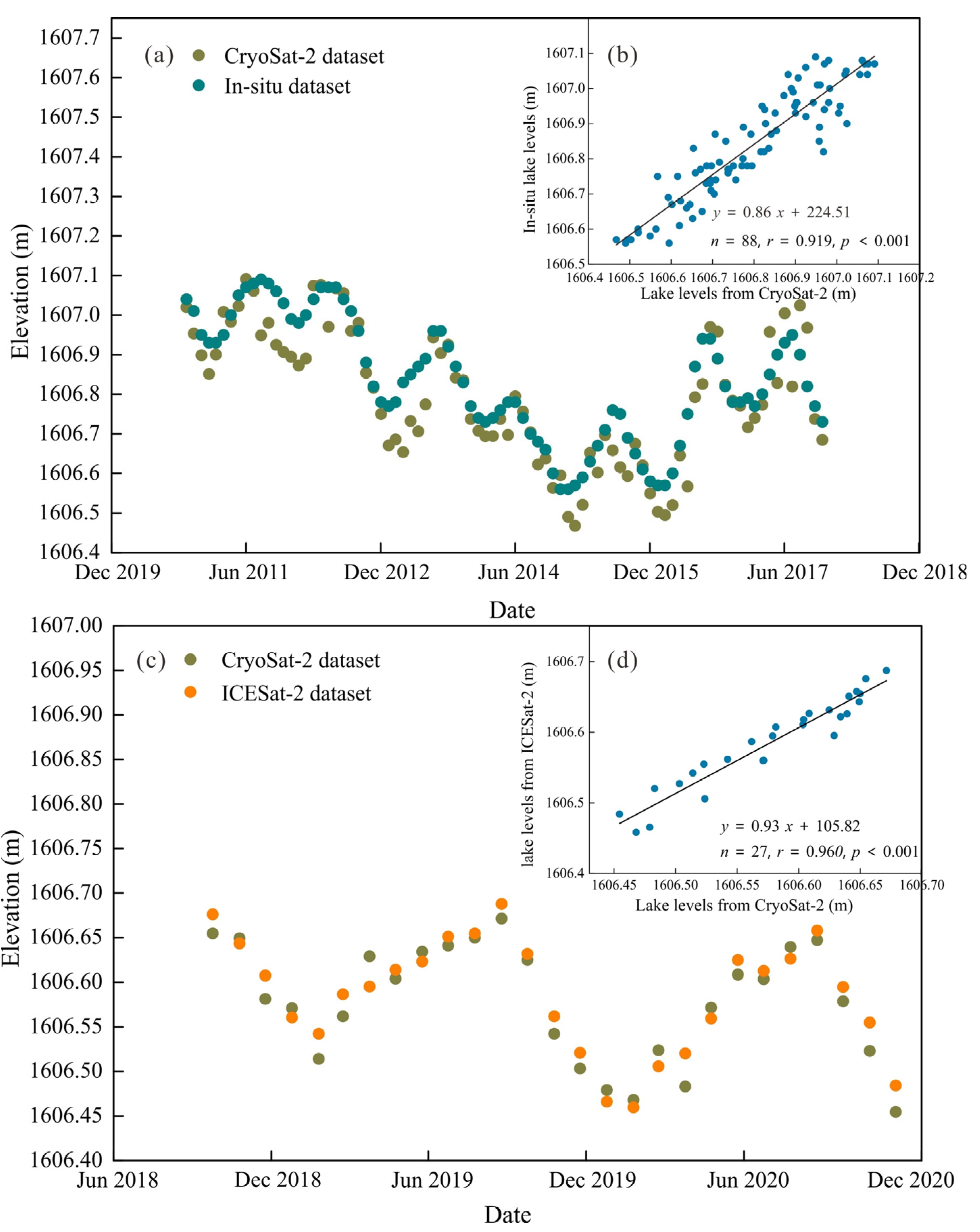

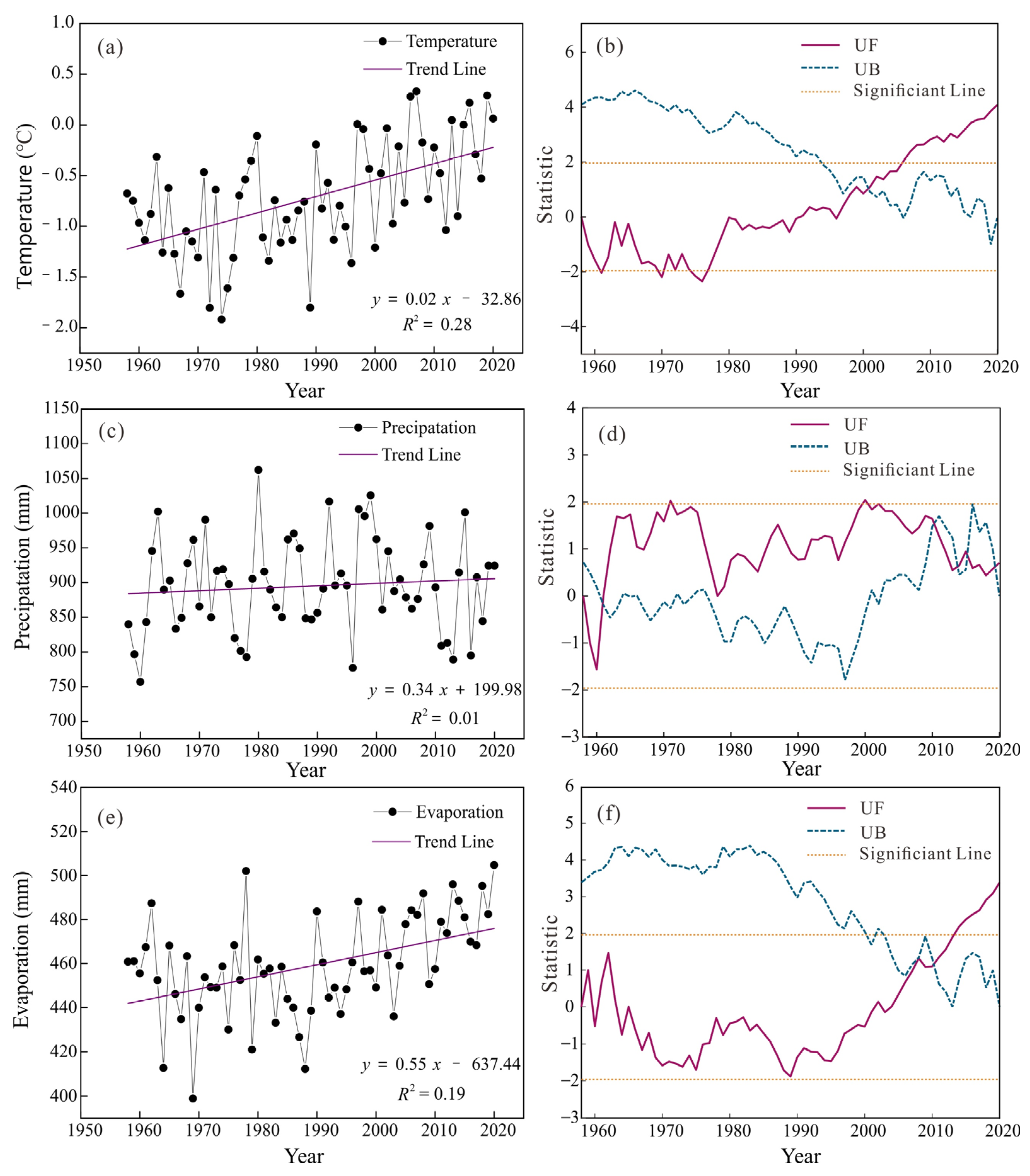
| Mission | CryoSat-2 | ICESat-2 |
|---|---|---|
| Agency | European Space Agency (ESA) | National Aeronautics and Space Administraion (NASA) |
| Primary instrument | SAR Interferometric Radar Altimeter (SIRAL) | Advanced Topographic Laser Altimeter System (ATLAS) |
| Operation time | April 2010~present | September 2018~present |
| Orbit altitude (km) | 730 | 500 |
| Inclination angle (°) | 92 | 92 |
| Repeat cycle (day) | 369 days with 30-day subcycle | 91 |
| Beam number | Two beams | Six beams |
| Footprint diameter (m) | 1650 m for LRM mode | ~17 |
| Sampling interval (m) | 300 | ~0.7 |
| Precision (cm) | 1~3 | 6.1 |
| Datasets | Landsat 8 Surface Reflectance Tier 2 | Landsat 7 Surface Reflectance Tier 2 | Landsat 5 Surface Reflectance Tier 2 | JRC Monthly Water History, v1.3 |
|---|---|---|---|---|
| Dataset Availability | 11 April 2013–28 September 2021 | 1 January 1999–15 October 2021 | 1 January 1984–5 May 2012 | 16 March 1984–1 January 2021 |
| Dataset Provider | USGS | USGS | USGS | EC JRC/Google |
| Earth Engine Snippet | LANDSAT/LC08/C01/T2_SR | LANDSAT/LE07/C01/T2_SR | LANDSAT/LT05/C01/T2_SR | JRC/GSW1_3/MonthlyHi-story |
| Spatial resolution (m) | 30 | 30 | 30 | 30 |
| Number of bands | 11 | 7 | 7 | 1 |
| Positional accuracy (m) [60] | <12 | <50 | <50 | <50 |
| Reference | Period | CC | p | MAE | RMSE |
|---|---|---|---|---|---|
| In situ data | July 2010–December 2017 | 0.919 | p < 0.001 | 0.060 | 0.075 |
| ICESat-2 data | October 2018–December 2020 | 0.960 | p < 0.001 | 0.018 | 0.020 |
| Period | Agriculture (106 m3) | Manufacture (106 m3) | Household (106 m3) |
|---|---|---|---|
| 1980–1989 | 2029.42 | 17.74 | 27.02 |
| 1990–1999 | 981 | 9.46 | 18.06 |
| 2000–2014 | 461.76 | 8.74 | 16.55 |
Publisher’s Note: MDPI stays neutral with regard to jurisdictional claims in published maps and institutional affiliations. |
© 2022 by the authors. Licensee MDPI, Basel, Switzerland. This article is an open access article distributed under the terms and conditions of the Creative Commons Attribution (CC BY) license (https://creativecommons.org/licenses/by/4.0/).
Share and Cite
Zhang, Y.; Wang, N.; Yang, X.; Mao, Z. The Dynamic Changes of Lake Issyk-Kul from 1958 to 2020 Based on Multi-Source Satellite Data. Remote Sens. 2022, 14, 1575. https://doi.org/10.3390/rs14071575
Zhang Y, Wang N, Yang X, Mao Z. The Dynamic Changes of Lake Issyk-Kul from 1958 to 2020 Based on Multi-Source Satellite Data. Remote Sensing. 2022; 14(7):1575. https://doi.org/10.3390/rs14071575
Chicago/Turabian StyleZhang, Yujie, Ninglian Wang, Xuewen Yang, and Zhonglei Mao. 2022. "The Dynamic Changes of Lake Issyk-Kul from 1958 to 2020 Based on Multi-Source Satellite Data" Remote Sensing 14, no. 7: 1575. https://doi.org/10.3390/rs14071575
APA StyleZhang, Y., Wang, N., Yang, X., & Mao, Z. (2022). The Dynamic Changes of Lake Issyk-Kul from 1958 to 2020 Based on Multi-Source Satellite Data. Remote Sensing, 14(7), 1575. https://doi.org/10.3390/rs14071575






